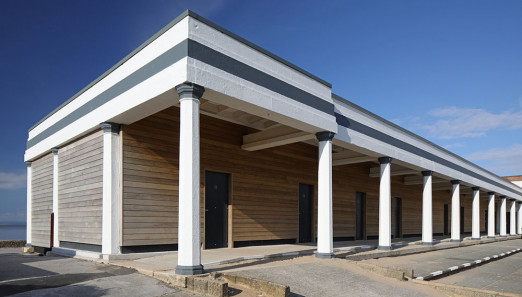Despite the rise of composite decking options such as Trex, timber remains a popular choice for both cladding and decking, with local authorities, architects and developers specifying timber for aesthetic and practical reasons.
The material creates a beautiful effect that helps structures to blend with the natural and built environment around them. Timber is built to last, with a life expectancy of decades, and there are undeniable environmental benefits of working with a natural, sustainably-sourced material. It’s also very easy to work with, being lightweight and easy to trim and fit when compared to alternatives like PVC.
Thermally treated timber adds an extra dimension to an already attractive choice, improving its environmental credentials and meaning it lasts longer. Howarth Timber’s products are at the forefront of this developing trend, with options to suit any environment.
Why choose thermally modified timber?
Thermally modified timber has been heat-treated in such a way that its cell structure is permanently altered. The treatment penetrates all the way through the wood, and timber that has been thermally modified giving it a uniformity of colour.
The thermal treatment gives timber an unrivalled stability with less swelling and warping than untreated wood, giving it greater longevity than raw wood. There are no chemicals involved in the treatment, making it environmentally sound, and unlike chemical treatments, thermally treated wood won’t rot at the core where the chemicals may not be able to penetrate.
Aesthetically, thermally modified wood looks natural and clean when it is weathered – unlike chemically treated timber, which can be stained or damaged by the process – and unlike untreated timber, the reduced moisture in the timber means it weathers evenly providing a clean even appearance.
Durability that’s ideal for decking
Thermally modified timber is a good choice for decking, thanks to its weatherproof qualities and natural appearance.
Howarth Timber offers customers three options of thermally treated decking from its Lunardeck range: spruce, redwood or ash; all of which can be certified to either FSC or PEFC so customers can trace the provenance of the timber and be assured that it is sustainably sourced.
Decking built from thermally treated timber is less subject to rot or warp, and unlike traditional softwood decking there is no need for re-treatment. The thermal process even eliminates the chance of insect and fungal damage to the deck. Under normal conditions, the end user could expect their decking to last for 30 years or more.
A clear advantage for cladding
Thermally treated cladding gives buildings a finish that looks good and allows it to blend with its environment. Howarth Timber recently supplied ArborClad’s Frake timber cladding for a project in Fleetwood, where it was specified for both the town’s observation tower and 10 beach chalets.
In this case, the material’s durability was a clear advantage, but there was a safety consideration at play too as thermally modified timber can be treated to protect it from fire, which was a prerequisite for Fleetwood’s observation tower.
A key component of cladding is the weatherproofing, and as thermally modified timber has increased weather resistance it is an obvious choice. This increased resistance to moisture means that the cladding is also suitable for indoor use, such as in a bathroom, wetroom or steam room.
There are clear environmental advantages to using timber cladding too, which is why Marks & Spencer chose thermally treated FSC-certified spruce cladding for its multi-million-pound northern distribution centre in Bradford, West Yorkshire – a low carbon facility designed to meets the demands of M&S’s ‘Plan A’ environmental initiative.
Timber cladding is 100 per cent recyclable, so it can be invaluable to building projects that include firm targets relating to carbon neutrality. Projects that require temporary cladding can also turn to timber for a solution that can be demounted and reused. What’s more, cladding acts as an insulator, reducing the building’s energy costs and muffling outside noise.
With a host of benefits, easy installation and unbeatable environmental credentials, thermally modified timber will be part of the landscape for a long time to come.


